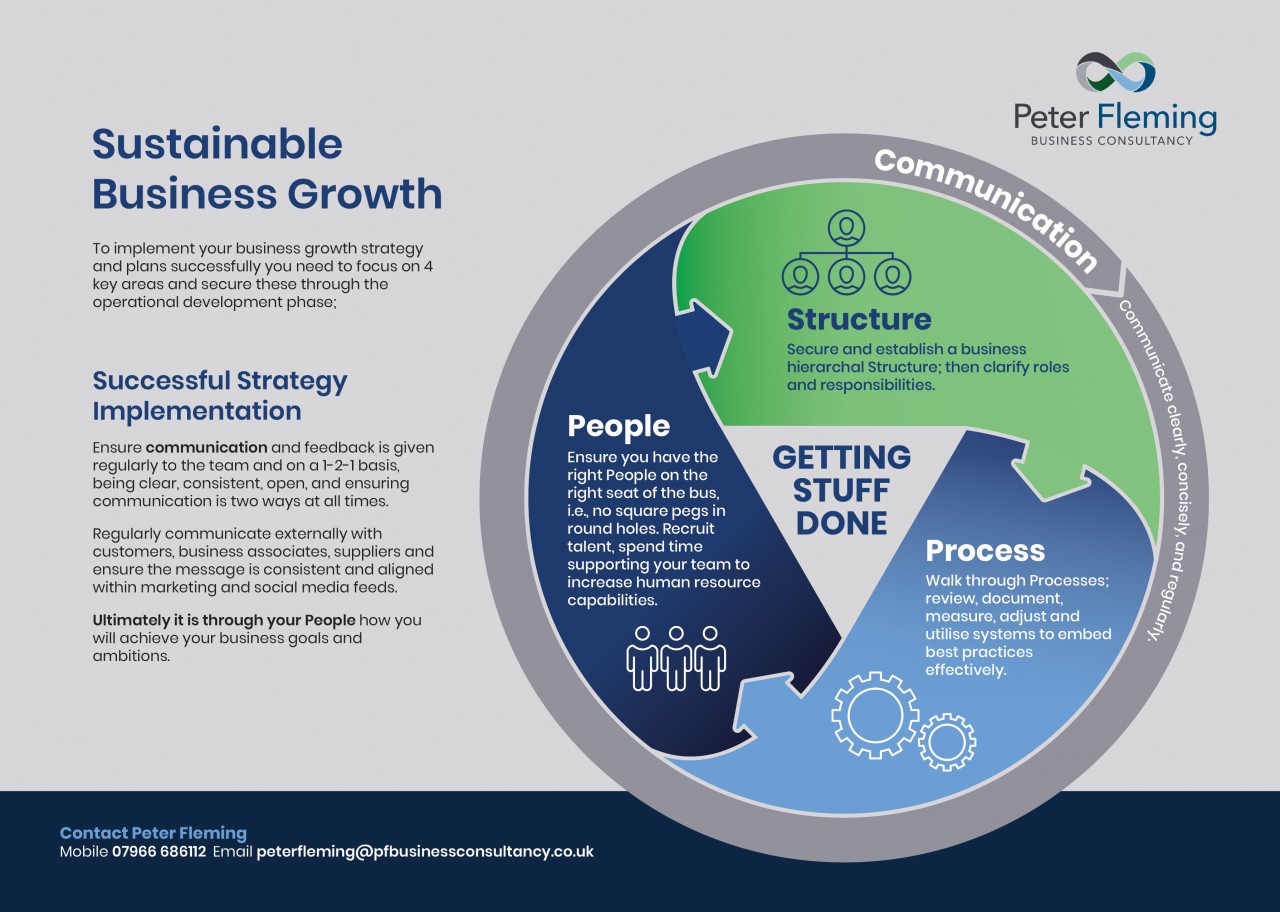4 key areas to obtain Sustainable Business Growth.
Less than 50% of new businesses and start-ups survive their first 5 years of trading, however those that do, tend to hit a glass ceiling when it comes to pursuing continual strategic growth. There are a number of reasons why this is the case and in the following article I'm going to focus on the 4 key elements that as a business owner or business leader you have to prioritise to ensure your team, pull together, in the right direction and continually innovate to stay ahead of the pack.
First and foremost, to obtain sustainable business growth you have to constantly review, analyse, learn, plan, and then adapt to deliver successful operational change i.e., working in incremental steps as the dynamics within the industry sector you operate in, evolves. This is about spending time continually aligning your businesses resources and developing the businesses capabilities to maximise the opportunities that come your way effectively and also to stave off the competition, who will be adapting and developing to market conditions too.
So, for a start, as a busy leader, you need to park some time to work "on" the business and get yourself out of the "too busy box".
4 key business areas to secure, to achieve Sustainable Business Growth.
#1. Structure
With a blank piece of paper, map out the current hierarchical structure of the business. Plot down all the roles, key responsibilities, and the current reporting lines within the business, as they are today. Include any outsourced contractors too, as they also need an element of management by someone in your team.
Then think ahead, strategically,
- Where do you want the business to be in 3 years-time?.
At a high level,
- What would the future turnover be?
- How would you see the sales channel functions developing?
- What products and/or services will you be offering in the future?
- What would the future operational structure ideally look like.
- Then plot the roles and responsibilities and reporting lines for the future operational hierarchy
However, don't put any names in boxes and it's worth as a 2nd exercise, at a later point, capturing the key person attributes and person specification, knowledge and skills for each of the main roles.
Then if you go back to the current structure you mapped out first, question:
- Is today's structure, fit for purpose?
- How do we need to adapt and what would need to change, first?
- Plot over the short term, an interim period, how you could reorganise and restructure the roles and responsibilities within your business to start on a journey to meet the future requirements.
If there are obvious gaps in capabilities, knowledge, and experience, highlight these and we will cover personal development further down this article.
When it comes to structure, also think about and plan ahead for infrastructure, equipment, outsourced business support functions, finance structure and working capital requirements along with the team meeting structure and rhythm, which I cover in more detail in #4. below.
#2. PROCESSES
The next step; to develop and improve internal human capabilities, you will need to find time for everyone within the business. Therefore, by discovering and reducing waste (time & materials) and securing efficiencies within the existing business processes.
A simple way to carry out this exercise is to walk through each of the businesses processes. Sales wise, from "find the customer" to "create proposal" and "obtain order" and also look operationally from "order" to "planning" to "manufacturing and or service delivery" to "invoice" and not forgetting any "follow up" processes too.
I can almost guarantee, you will find duplication, bottle necks and sticky points causing delays and waste, along with varied understanding and different ways of working based on existing processes. Therefore, with your team agree how to secure and implement any best practices.
However, don't forget to investigate how to utilise effectively your current systems and IT too and also consider upgrading software packages to improve workflows. The more you can automate, process wise, the more consistent workflow will be, offering a higher level of customer service and freeing up time for your employees.
To note, there is help out there and it's worth looking at Digital Tech Cumbria. ( https://dtc.winningmoves.com/ ) DTC offer diagnostics and specialist digital consultancy to improve technology use and digitalisation.
In many instances when I've worked on mapping and securing best practice across business processes, the one common piece of feedback we get from employees is, "Rather than just firefighting every day, we've now got so much more time to focus on improving tasks which allows us to move the business forward".
#3. PEOPLE
Then with these gains in time, as the business leader you need to spend time getting your People to excel at what they do and become the best version of themselves.
As a leader this involves spending time observing, listening, and giving positive and constructive feedback through regular one to ones. Ideally support your staff's development through coaching and mentoring your future stars within the business. Obviously you can't mentor everyone within the business so you will need to develop your team leaders and managers to be effective in developing their line reports too. If you spot any expertise, ensure you buddy up employees so there is effective knowledge and skill transfer. In bigger organisations you can introduce cross functional peer coaching too, different departments, divisions leaders supporting each other's development. Ensure any agreed personal development plans and feedback during annual reviews are followed up. If your employees get the opportunity to develop their skills and knowledge they will then have the opportunity to fulfil those future roles you highlighted as gaps in the first exercise above.
#4. COMMUNICATION
The final piece and most important to keep the momentum going "oiling the wheel" is to ensure Communication is clearly, concisely, and regularly delivered.
That means holding full employee briefings, no more than twice a year, where you, the business leader, share the vision, business results, next steps, and any challenges. Involve the team to come up with ideas and suggested solutions, as they tend to be on the front line, close to your customers and operations and may have some business improvement suggestions that you and your senior team haven't considered.
Also facilitate and support your managers, direct reports in delivering regular team meetings, monthly is ideal but find a rhythm that suits and adds value to your organisation. Communication should always be open, two way. Plus ensure that any marketing, PR, and any online activities such as through the website, social media, are aligned and share the same key messages and follow the same themes, strategically linked to your overarching business vision.
Ultimately as stated at the beginning of this piece, you will need to find time, to implement business organisational change effectively. Therefore, it's about changing your own behaviours and habits first and then adapting your way of working. If you can achieve this first step and then spend part of your time, becoming more strategic, implementing and prioritising the appropriate tasks; securing the future structure, finding efficiencies within internal processes, and developing your team through effectively communicating, I'm sure your business will grow sustainably.
Key though and it's worth remembering, it's only through your people and your team that you can achieve your long-term business vision and goals.
So, keep it simple, don't over complicate things and focus on becoming "brilliant at the basics".
I've embedded a one pager explainer graphic below, which capture the key points within this article, however if you wish to share and chat through any obstacles or hurdles, that you may foresee, in taking your business forward to the next level, my contact details are below.
Peter Fleming
Mobile 07966686112
Email; This email address is being protected from spambots. You need JavaScript enabled to view it.
Comments
By accepting you will be accessing a service provided by a third-party external to https://www.pfbusinessconsultancy.co.uk/


